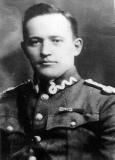
Merian C.Cooper |
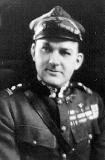
C.Fauntleroy |
Being of Polish heritage and passionate in reading about the triumph of liberty over tyranny, I was pleased to discover the exploits of Merian C Cooper. I am in awe of the power a positive role model can have in forming character and influencing and shaping life. I find this story of Cooper, Pulaski, Kosciuszko and others so moving I am compelled to share what I know with you.
Merian Caldwell Cooper was born in Jacksonville Florida on October 24th, 1893 and he died in San Diego on April 21, 1973. As a youngster, Cooper enjoyed listening to his parents stories. The story about Casimir Pulaski, in particular, would preoccupy him. Being young and impressionable he listened keenly as his parents recounted the courage, heroism, virtuoso horsemanship and sacrifice made for freedom by Casimir Pulaski, in fighting for Amercan independence. Cooper felt a deep, personal and long lasting gratitude to this young man who had come from far away Poland to help America in its hour of need. He was impressed by Pulaski's statement to General George Washington:
"I have come where freedom is being defended to serve it, and to live and die for it."
Cooper was excited to hear that his Great Great Grandfather, Colonel John Cooper, had not only been a senior officer in Pulaski's cavalry unit but also his close friend. His heart sank with sadness hearing that the 34 year old had been wounded and died shortly after the Battle of Savannah. Merion, however, felt a sense of pride to learn that his Great Great Grandfather had personally carried the mortally wounded Pulaski from the battlefield. The fact that Pulaski died in the Colonel's arms brought him to tears.
This poignant tale remained indelibly implanted in Merion Caldwell Cooper's mind and from then on, he had a yearning to emulate Pulaski's valour, daring and the fearlessness he showed in fighting for American liberty. He vowed that if he ever had the opportunity, he would strive to personally repay America's debt to Poland for Pulaski's sacrifice. The rest of Cooper's life is testimony that he kept his word. Mark Cotta Vaz captures the essence of this in his biography of Cooper, 'Living Dangerously', and what you will read here is a brief summary of an incredible life.
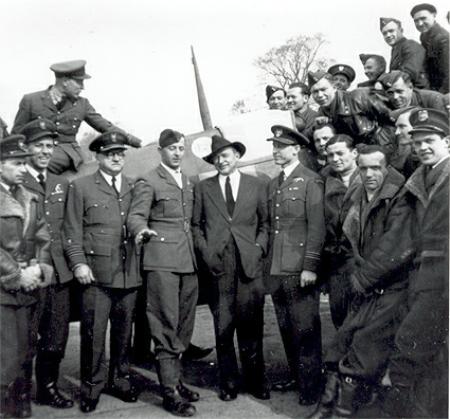
Cooper 1941 With 303 Group |
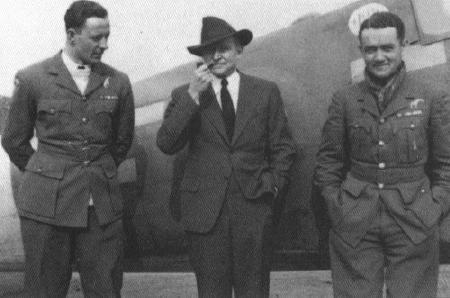
Cooper With ZumbachFeric |
Cooper enlisted and fought with General Pershing in the Pancho Villa expedition. After training as a Pilot he fought in WW1 and was shot down over Germany and despite being badly burned, he rescued Edmund Leonard, his 'observer' who had been shot in the neck, dragging him from the flames of the crashed plane. Immediately after the First World War he joined Herbert Hoover in providing humanitarian aid to the starving in reborn Poland. Vaz writes pp 50 51:
“Cooper burned to fight for Poland. In another undated, handwritten letter to his father a correspondence that formed an emothional lifeline to home and a more peaceful world he recalled the childhood stories that had led him to this war torn place.”
"It grieves me every day that I am doing so little for the cause of Polish liberty, when Pulaski did so much for us, and I always remember the stories you have told me of how he died in my ancestor's arms . . . if I can return the debt to Poland at any time I stand ready to do so."
At the outbreak of the Polish/Soviet war, Merian Caldwell Cooper recruited a number of battle hardened American pilots who had remained in France, to form what would eventually be called the Kosciuszko Squadron. Merian was beginning to make good on his vow.
On May 19, 1919 he [Cooper] wrote a letter through channels to the commanding general of AEF [American Expeditionary Force] at Chaumont, France, which read in part: ... I got General [Tadeusz] Rozwadowski to take me to the Chief-of-State, Marshal Pilsudski. I immediately offered to resign from the United States Armed Forces to join the Polish Air Force. The Marshal misunderstood one thing. He thought I wished to become a soldier of fortune for money, I jumped to my feet and told him I would accept no promotion in rank until I earned it in battle, and that I would never accept one cent over and above what a Polish officer received. The fiery, piercing eyes of the Marshal looked at me for a second; then he stood and clasped my hand.(Flight of Eagles Pp 15-16)
The squadron was named after Thadeusz Kosciuszko, another Polish freedom fighter in the American war for independence, whom Thomas Jefferson described as:
"The purest son of liberty . . . . I have ever known, the kind of liberty that extends to all, not only to the rich."
Kosciuszko was renowned throughout Britain, Europe and America. Poets of the calibre of Keats, Lord Byron, Samuel Taylor Coleridge were inspired to write of him. Most resounding to me, however, is the verse of the less well known Scottish Poet, Thomas Campbell, in the ‘Pleasures of Hope’ and these stirring words can be found on the Kosciuszko Monument in Lafayette Park, Washington DC.
Hope, for a season bade the world farewell,
And Freedom shrieked — as Kosciuszko fell!
After the Squadron was formed and just before they were about to go into action, a farewell reception was held for them at the Hotel Ritz in Paris where they were introduced and farewelled by Jan Ignacy Paderewski, world famous pianist and the Premier of Poland at the time.
[Paderewski] spoke words of glowing praise for the spirit that brought the group of young pilots before him; and he personally offered them the sum of thirty-five thousand francs from his own fortune to help defray their original organization expenses. But his gracious offer was declined by the fellows who all felt that their services should be upon the same basis as any other unit in the Polish Army. (Wings Over Poland P15)
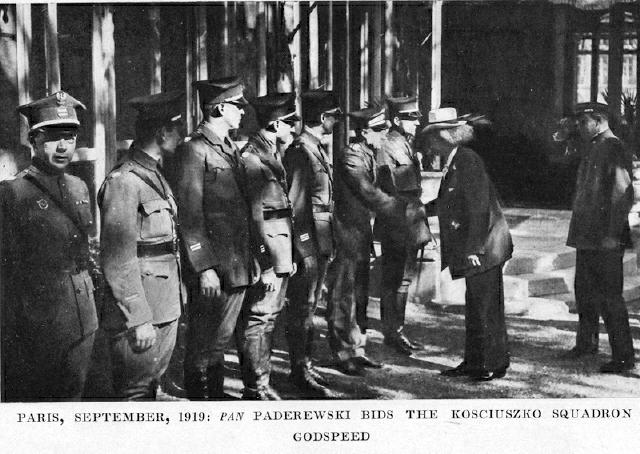
Paderewski Greeting Kosciuszko Squad |
Cedric E. Fauntleroy led the squadron because he outranked Cooper at the time. This handful of Americans, with their 'can do' spirit and incredible bravery flying daily missions from before dawn till after dusk, made the difference and helped Poland win what became known in history as the Miracle on the Vistula. A war, ranked by Edgar Vincent D'Abernon, The Eighteenth Decisive Battle of the World: Warsaw, 1920, Hyperion Press, 1977, as one of the World's most decisive battles because it saved Western Europe from the onslaught of Communism.
What Polish people today recognise as the insignia of the Kosciuszko Squadron of World War II was actually designed by Eliot Chess, one of the original American pilots of the original squadron, who was a Graphic designer by trade. He brought American and Polish elements together. The thirteen stripes and thirteen stars are borrowed from the American flag, representing the thirteen original colonies and the scythes, rogatywka and feather symbolise Kosciuszko and Poland.
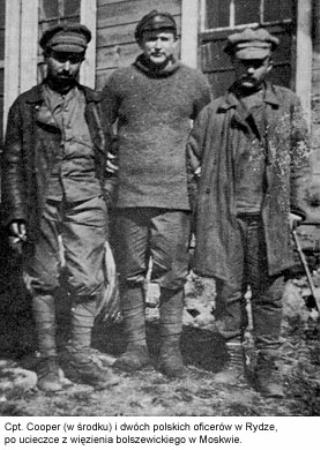
Escapees |
[Eliot] Chess was the designer of the Kosciuszko Squadron insignia, used only by the 7th Squadron planes ............ The ensign was designed upon the back of a restaurant menu, while Chess and a few of the other pilots were seated in the large oval dining room of the Hotel George, in Lwow. .......... Chess, by then known to all and sundry as Chesski, began making a sketch on the back of the menu card.
His pencil first traced the outline of a plain white disk, and then, just inside the line, he fitted an inner circle of thirteen equally spaced little blue stars. Inside the ring of stars he drew the vertical red and white bars of the United States shield, and then he hesitated .......... His mind travelled back to the days of Tadeusz Kosciuszko, when, still a young man striving against the great division of Poland, he had valiantly led his loyal Polish peasant troopers straight up to the roaring muzzles of the Russian guns .......
...Chesski’s blood tingled as his mind traced out the action of that gallant charge, the peasants in their brilliantly colored sheepskin jackets, armed only with their own farmyard scythes - the great long blades had been removed from their curling, crooked handles and placed pointing straight onward from the tip end of heavy staffs of great length ...... He drew the menu card toward him and began rapidly sketching in the heavy outlines of two of the scythe-weapons of Kosciuszko’s men. Slanting upwards across the face of the American shield within the circle of stars he drew them, the long staffs crossing near the middle, the tip end of the handles extending a trifle below the rim of the outer line, the thin points of the wicked scythe-blades going just above the top. Then, in the very center of the drawing, he worked in a tiny replica of the jaunty, four cornered, red velvet cap Kosciuszko wore, its black astrakhan headband holding the cocky bit of colored feather which was the only designating mark of his command. [Designed circa October/November 1919] (Wings Over Poland Pp 35-36).
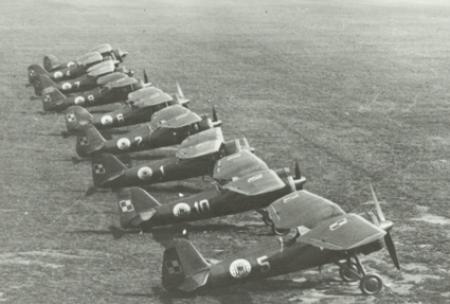
Kosciuszko planes |
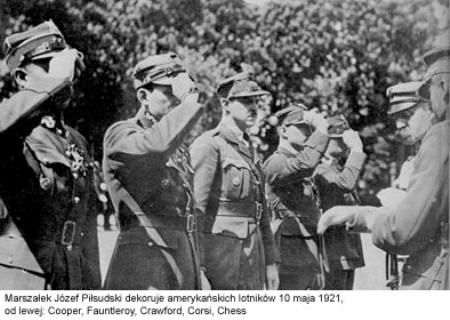
Virtuti Militari Presentation by Pilsudski |
The American pilots and the Polish field crew were able to keep the Kosciuszko Squadron close to the battlefront by improvising a mobile airforce using railroad boxcars as a type of 'aircraft carrier', reassembing, moving, dismantling and loading the planes on the wagons. The train was the squadron's headquarters, spare parts store, munitions store, food supplies store, hospital and kitchen.
Having the planes always at the battlefront, bombing and strafing Semyon Budenny Southern Cavalry, allowed the Polish forces to successfully retreat west from the Ukraine, to help defend Warsaw. These magnificent few pilots then played a critical role in the next stage of the conflict. They continued with their bombing and strafing, stopping Semyon Budenny from linking up with Tukhachevsky’s north west manouevre around Warsaw. Poland's Marshall Pilsudski seized the moment, putting into action a surprise plan, risky and daring. Instead of concentrating his forces on the western part of Warsaw, he moved his strongest units north, attacking Tukhachevsky's rear, cutting off his supplies and escape route to the Soviet Union.
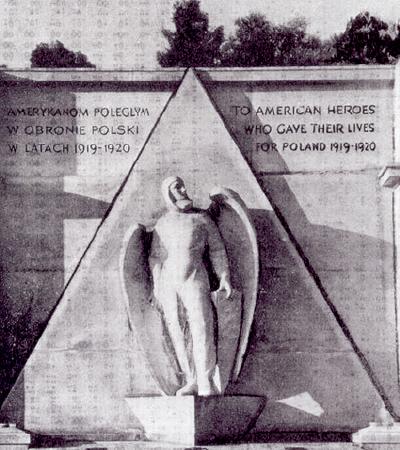
Lwow Memorial Pre1946 |
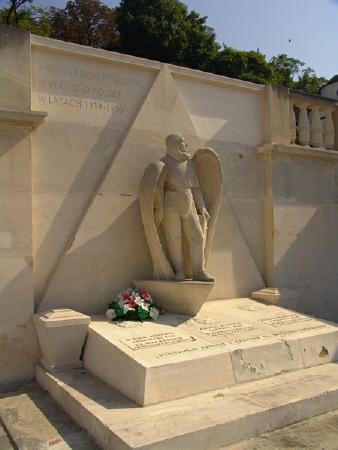
Lwow Orleta 2005 |
In the middle of this battle, after completing more than 70 courageous missions, Cooper was shot down, captured and but for the intervention of a regimental Cossack commander, would have been beheaded. His captors had placed a noose around his neck and riders were slashing with their sword making sport, with each pass coming a little closer than the last.
American air interdiction had been so effective at stopping the Soviets that Semyon Budenny had put a price of half a million rubles on Captain Cooper's head. Cooper was able to talk his way out of execution by showing his burned and calloused hands as evidence that he was a 'working man' and not a dangerous bourgeois. The fact that he was wearing army surplus clothing helped him trick the Cossacks, because his clothes were labeled with the name of a Corporal Frank Mosher instead of his own name and officer rank.
Cooper recounts his time as a POW in 'The Things Men Die For', written under his pseudonym,‘C’. He expresses gratitude for a morale boosting act of charity by a Russian country lass. Riding on a prison wagon to Moscow, his train would occasionally stop to pick up or drop off locals, mainly sturdy peasants. At one stop a beautiful girl, with soft brown eyes, entered the cattle wagon Cooper was being held in. On seeing him, and the state he was in, she took empathy. After a while, this ‘angel’ convinced the guards to let her help the dirty, sick, undernourished, thirsty and badly injured prisoner who was in such obvious pain and looked close to death.
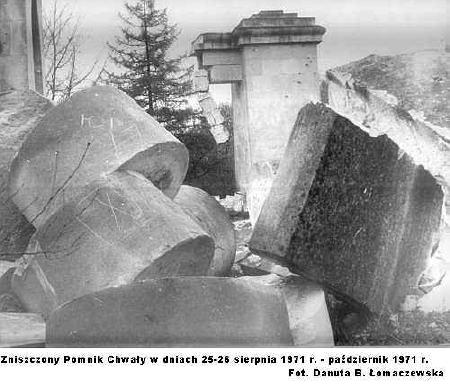
Lwow Orleta After 1946 |
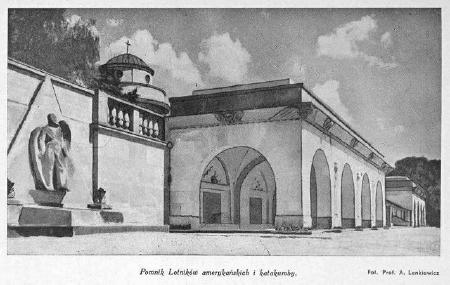
Lwow Orleta Pre1946 |
This unlikely pair conversed in French and he found out that she had recently recovered from Typhoid, had lost her mother, father, and only brother because of the war and the Russian revolution. Now, after three months of hard work, she had saved 40 000 roubles with which she could make her life better by being able to afford to buy bread, sugar, butter and meat.
"I will get back the rose in my cheeks." She said with a sparkling smile.
Over three days this 'good Samaritan' had shared her food, brought him water, tended to his wounds and made conversation that lightened Cooper's heart. Suddenly, on the fourth morning, she told him that she was getting off soon, secretly passing him an envelope that he had to promise not to look at till after she was off the train. When she had vanished into the Russian ether, when the guards were not looking, Cooper opened the envelope to find four ten thousand rouble banknotes!
"She had given me the rose of her cheeks."
This unforgettable three days had lifted Cooper's spirit and helped him survive his current and future dreadful circumstances. Only two of 5 000 printed copies of this book are known to be left in existence. Cooper in 1933 had married cinema actress, Dorothy Jordan, and he decided to withdraw this book from sale because it contained references to his out of wedlock relations with ‘Nina’,actually, Malgorzata Slomczynska. Cooper had returned to America but he had left behind a son, Maciej Slomczynski, who would grow up to become a famous writer and translator in Poland.
One copy of this book is currently available for sale for about $A2100, from The Reader's Quarry, Box 752 Woodstock , New York 12498 United States. It is offered for sale with this description:
New York: Putnam's, 1927 This incredibly scarce copy is bound in navy blue cloth with gilt titles and border. No wear or marks to book. Appears unread. DJ is bright and clean, with just a bit of wear to edges; has been protected by a glassine jacket that looks original. By the producer of King Kong, Merian C. Cooper.
Any buyers? I would love to borrow and read it! The other copy is in the Library of Lawrenceville University, at Princeton New Jersey.
A hard life of railway trackwork, in freezing Russian conditions, ensued. During his captivity the young American had to cope with the anguish of being told on three separate occasions that he was to be executed at dawn. At one time, he found himself looking down a gun barrel and hearing a click when the trigger of the empty rifle was pulled.
Barely surviving ten months of captivity, Cooper and two Polish prisoners, Lieutenant Stanislaw Sokolowski and Lieutenant Salewski, were able to escape on a night the guards didn't bother to go on duty, because they believed that it was so cold, any prisoner who tried to run away, would face certain death in the wilderness. Trekking 700 kilometres over desolate and mostly hostile country, emaciated but avoiding capture, with Cooper acting as a deaf mute, the three escapees eventually found their way to freedom in Latvia, on the 23rd of April, just 11 days after their break out.
By this time the War had ended and Cooper, together with eight other Americans and three Polish pilots serving with the unit, were presented with Poland's highest military honour, the Virtuti Militari. The fact that more than half of the American Kosciuszko Squadron had won this award in the Russian/Bolshevik War of 1919 1921, clearly indicates the crucial role played by the ‘7th Squadron’ in saving Poland and Western Europe from the tyranny of Communism.
Echoing Kosciuszko’s magnificent deed in liberating slaves and using his assets to provide for their education, the American pilots made a similar gesture to Poland.
A small land grant in Poland - which accompanied the Virtuti Militari decoration - was offered to the Americans, but they settled for a counter proposal. Their lesser holdings were combined into one larger unit which contained a comfortable chateau; and the resultant estate was turned over to the Polish Army for use as a convalescent home by the wounded soldiers of the free and independent nation of the White Eagle! Flight of Eagles P233
Cooper, as well as Fauntleroy, Crawford, Corsi and Chess, were presented with the Virtuti Militari by Jozef Pilsudski on the 10th of May 1921, at the Belvedere Palace, Warsaw. Clark, Rorison, Noble, Shrewsbury, Weber, Konopka and Senkowski received their Vurtuti Militari at other times and places. Cedric E Fauntleroy’s uniform is on view at the Polish Museum of America in Chicago, Illinois.
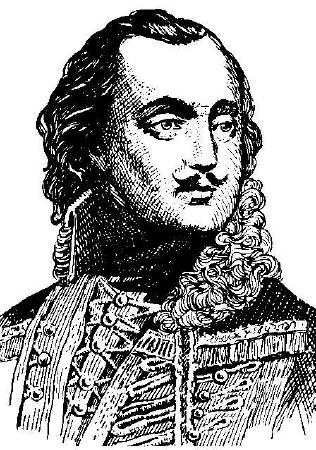
Casimir Pulaski |
After being demobilised Cooper, impossible as it may be to believe, now began a life of difficult, dangerous and daring adventures filled with achievement! The brief outline that follows here really doesn't do Cooper justice.
* sailed on the Wisdom in an incomplete around the world expedition which included an encounter with Haile Selassie and he filmed Ras Tafari's army conducting manoeuvres
* worked as a reporter for the New York Times
* filmed pioneering documentaries in Thailand, Iran and the Sudan such as Grass and Chang.
* helped to establish intercontinental air travel with Pan Am
* Authored a number of books including Things Men Die For, Grass, King Kong, The Sea Gypsy, Under the White Eagle
* As creator of King Kong he also wrote the screen play, produced, directed and acted in the movie and helped with the special effects
* Produced and directed many highly rated movies with RKO and Argosy productions where Brigadier General Merian C Cooper and Rear Admiral John Ford made films such as Rio Grande, The Quiet Man, Fort Apache, She Wore a Yellow Ribbon and the Searchers starring John Wayne
* Successfully ran RKO
* Enlisted for active combat in WW2 even though he was nearly 50 years old. He was the leader of Force Aquila which was planned as a payback hit on Tokyo for the Pearl Harbor attack, but preference was given to the parallel Doolittle mission.
* Flew missions with distinction in Chennault's Flying Tigers supplying China with flights over the Himalayas from India.
* Flew in New Guinea with the 5th Air Force playing an important role in the destruction of Japanese air power
* Was part of General Douglas MacArthur party on the Missouri for the Japanese surrender
* Helped develop and promote Cinerama and Technicolor and won an Oscar for his achievements in film
* During World War II he was awarded the Order of Polonia Restituta. The only Brigadier General I know who was part of the Japanese surrender, with the Virtuti Militari, Polonia Restituta and an Oscar!
For all his accomplishments, Cooper was especially proud of founding the Kosciuszko Squadron. During his visit to Northolt [England] in 1941, the pilots [of the 1941 Kosciuszko Squadron], who had formed up to greet him, shouted in unison: “Honor to you, heroes!” - the same acclamation that Cooper, Fauntleroy, and the other Yanks had heard when they had departed Poland in 1921.
Cooper, wearing a rakishly tilted fedora and smoking a briar pipe, was visibly moved. He told the Poles that the accomplishments of the American pilots of the Kosciuszko Squadron had been “but a little thing compared with your present wonderful record.” He was particularly touched he said by the sight of the Kosciuszko insignia - the cape, crossed scythes, and stars and stripes - on the squadron’s Hurricanes. He and the other original pilots were proud of that insignia, he said, because it stood for “the friendship of the United States and Poland throughout the pages of history.” (Question Of Honor Pp 171-172)
Barely visible in the photo above, just to the left of Cooper’s hat, on the Spitfire, is the Kosciuszko Squadron emblem, that had been designed by Eliot Chess way back in 1919.
Edmund P Graves, Arthur H Kelly and T V McCallum were killed in service and at the end of the war, a ceremony was held at the Cemetery of the Defenders of Lwow. A monument was erected with the simple but poignant inscription, ‘They died so that we could live free’. The Soviets tried to eradicate all memory of these heroic pilots and their contributions to the Polish/Bolshevik War of 1919-1921, by demolishing the monument and desecrating the graves. However, reconstruction works, begun in 1989 by local Polonia and Poles working temporarily in Lwów, were completed in 2005.
The most expensive film ever produced in Poland before World War II, titled Gwiazdzista Eskadra, was a heroic portrayal of the exploits of Cooper and the Kosciuszko Squadron. It was produced by Leonard Buczkowski, but it proved to be an inconvenient work and unfortunately all copies of this 1930 Polish film were destroyed by the Soviets after World War 2. There are many people searching the world for this film in the hope one has survived in a vault somewhere. A description of the movie can be found on the following website.
filmpolski.pl
Tyrants may try to crush the human spirit by bulldozing monuments and cemeteries and destroying films but the human spirit cannot be destroyed. In a joint Polish/British production, a film about Cooper's life is being produced by Andrzej Bartkowiak (US Marshals, Lethal Weapon 4, Exit Wounds, Doom, Street Fighter) and is planned for release in 2010. The film is presently titled ‘Krzyz Walecznych’ and the latest developments about it can be found at the following website:
bizpoland.pl
Merian C Cooper lived an extraordinary life. He was one of the world's great champions of liberty. His attitude and life experience is reflected in the advice he gave Richard Cooper, just before his son went to fight in Vietnam.
"Son, everybody will tell you not to volunteer. I, on the contrary, tell you to volunteer for every dangerous and hazardous mission. You'll either come back thinking well of yourself and disregard all the [medals] they put on your chest, which means nothing, or they will put you in a pine box. In which case I will see that you are properly buried as your mother would desire." Mark Cotta Vaz p331 Living Dangerously
We who know and are proud of the deeds of Kosciuszko, Pulaski, Rejewski, Paderewski, Kuklinski, the heroes of the Warsaw Rising, of Monte Cassino, all the Polish heroes of World War II and all Polish champions of liberty, and how we strive to have them recognised to keep their heroism in living memory, it is incumbent on us to recognise, acknowledge and keep alive the part played by Cooper and the other members of the Kosciuszko Squadron in the Miracle on the Vistula. I sense that young people yearn for heroes to look up to and to model their lives on. It is uplifting to know people such as these thought enough of Polish culture to reciprocate ‘For Your Freedom and Ours’.
Bibliography
* Karolevitz, Robert F & Fenn, Ross S Flight of Eagles Sioux Falls Brevet Press 1974
* Murray, Kenneth Malcolm Wings Over Poland New York Appleton 1932
* Olson, Lynn & Cloud, Stanley A Question of Honour New York Knopf 2005
* Vaz, Mark Cotta Living Dangerously New York Villard Books 2005
Note
The Kenneth Malcolm Murray book, signed by the author, cost me $200. Murray was one of the American pilots of the Kosciuszko Squadron and he was notable in that he brought his own plane, a Sopwith Camel, to the fight! Other books published on this topic include Janusz Cisek, Kosciuszko We Are Here, and Tomasz Kopanski, Kosciuszko Squadron 1919 1921.
| 

